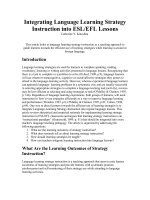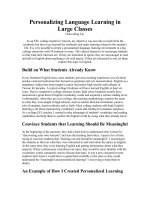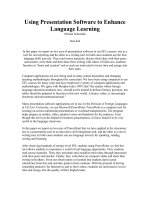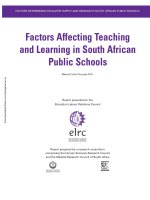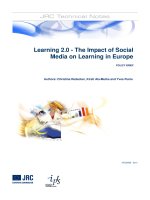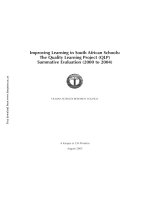Personalizing Language Learning in Large Classes(motivation)
Bạn đang xem bản rút gọn của tài liệu. Xem và tải ngay bản đầy đủ của tài liệu tại đây (63.34 KB, 3 trang )
Personalizing Language Learning in Large
Classes
Chao-ching Lin
As an EFL college teacher in Taiwan, my objective was not only to teach from the
textbooks but also to go beyond the textbooks and make learning related to the student's
life. It is very possible to create a personalized language learning environment in a big
college classroom with 50 students or more. The critical element is to encourage students
to find what their interests are. If they are interested in sports, they are encouraged to read
and talk in English about anything to do with sports. If they are interested in arts, let them
explore this topic in English.
Build on What Students Already Know
In my freshmen English class, most students' previous learning experience was all about
teacher-centered instruction that focused on grammar and rote memorization. English as a
mandatory subject has been taught in junior and senior high schools and colleges in Taiwan
for decades. A typical college freshman will have learned English at least six years. Due to
competitive college entrance exams, high school students usually have memorized a great
deal of English vocabulary words and acquired a certain reading level. Unfortunately, when
they go on to college, the teaching methodology remains the same as what they were taught
in high schools, such as teacher directed curriculum, passive role of students, basal
textbooks and so forth. Most college students still think English learning is all about
memorizing vocabulary words and reading for academic purposes. As a college EFL
teacher, I wanted to take advantage of students' vocabulary and reading capabilities and
help them to explore the English world by using what they already know.
Convince Students that Learning Should Be Meaningful
At the beginning of the semester, they had a hard time to understand what I meant by
"discovering your own interests" and start the learning from there. I spent a lot of time
trying to convince students that "learning can and should be meaningful". I encouraged the
students to find out what they were interested in and read about the topics in English. At
the same time, they were learning English and getting information about what they
enjoyed. If they continuously read about one topic, they would be more familiar with the
vocabulary words commonly used to discuss that topic. It was a new concept for most
students and I knew I would have to guide them carefully in the class so they could
understand the "meaningful and personalized learning" I was trying to help them to obtain.
An Example of How I Created Personalized Learning
Here is an example of how I created personalized learning in my college freshman class of
55 students. I designed several class periods based on environmental issues. I told them
why I chose the topic. I really care about the environment and am very interested in
knowing what's going on about the issues. I chose an article from the textbook about car
recycling. Before the reading, we discussed different issues about recycling locally,
nationally and globally. During the reading, I explicitly showed them how I read an article
and what I would do if I did not understand the vocabulary words. I looked at the pictures
and scanned through the subtitles. Did I check in the dictionary immediately or not and
why not? I told students to keep in mind that we were learning information as well as
English at the same time. We did not have to know every single word in order to get new
information from our reading. If the same vocabulary words appeared more than three
times, it must be an important word. I would circle the words and check with the dictionary
either during or after reading. At the beginning, it is important to limit the topic yet still
give students freedom to choose the articles they prefer. I assigned them to find an article
from . They can do the assignment individually or in a
group of no more than three. There were a wide variety of environmental issues they could
choose to read about. I also told them the reasons for this post-reading assignment from the
Internet. In the computer lab, I have noticed most of the students only browsed web sites in
Chinese. I wanted them to explore the enormous information available in English. They
needed to print out the article, read, and share the information with the class. I asked them
why they chose their article to read, how they read it, and what they did when they
encountered unknown vocabulary words. I told them if they were interested in
environmental topics, they should continue to read more and find out more. If they were
not interested in the topic, they should find other topics.
In order for students to share with others, I used two class periods, two hours each and first
asked if anyone would like to go in front of the classroom to share with their learning
process. If there were no volunteers, I would randomly select students to share with their
assignments. This was a good way to indirectly get students to do their homework. They
knew they had to be prepared.
There were five questions asked about how they did their assignments.
• First, why did they choose the articles?
• Second, what was the article about?
• Third, how did they read? Questions related to cognitive and metacognitive
strategies were asked.
• Fourth, what did you learn from doing this assignment? How was the process of
doing this assignment different from your past English learning experiences?
• Fifth, what did they do when they encountered unknown vocabulary words?
According to our guidelines, they were supposed to check a dictionary no more
than five times. What were their five vocabulary words? Why did they choose these
words to be checked? Could you list the five words on the blackboard?
Note that the sequence of the five questions asked is important. This helped students to
know that their choice of topic and information learned are more important in their process
of learning.
One student's research was about how a frog's skin colors are connected with the
environment. She said "I chose the article because frogs are more real to me than a grizzly
bear. I can see frogs everywhere, but I did not know how they are related to us
environmentally. Now that I know I have a different feeling about human, the animal and
the environment."
At the beginning of the semester, the syllabus was designed mostly using myself as an
example of how I learned new information and English in the topic I like. In order to guide
students through a new way of learning English, at first, I had the control of the topic yet
students still had choices within the topic. At the end of the semester, when students felt
more comfortable about a different way of learning English, they can choose whatever
topics they are interested in. In the classroom of 55 students, we had the same guidelines to
follow yet everyone was studying a topic of their choice.
Some students complained about the assignments for the class. They were only used to
reading in the English basal textbooks. I told them "What you read in your research is the
real English in the real world. You just need to get used to it by reading more. The textbook
is not real because it is purposely written for levels. I hope you go beyond the level.
Challenge yourself by reading real English. Discover your own interests and research
them." Some students had a hard time adjusting to my teaching style. There were times
when students were frustrated with the assignments. They didn't know how to discover the
topics they were interested in. They just cared about getting grades from the class. They
didn't care about critical thinking or global issues. They just didn't understand what these
issues had to do with learning English. But I was very determined to implement my
philosophy that successful language learners are researchers and lifelong learners. I
encouraged them to continue reading in English about their topics of interest even while
they are not in school. When they find the joy of reading and learn from the reading,
learning will never be a task.

